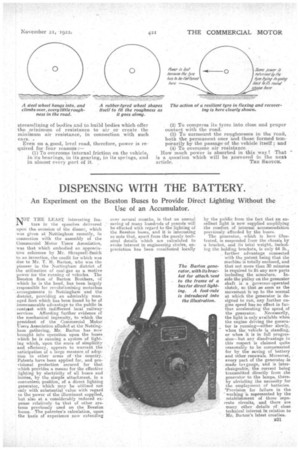DISPENSING WITH THE BATTERY.
Page 15

If you've noticed an error in this article please click here to report it so we can fix it.
An Experiment on the Beeston Buses to Provide Direct Lighting Without the Use of an Accumulator.
NOT THE LEAST interesting feature in the speeches delivered upon the, occasion of the dinner, which was given at Nottingham recently, in connection with the assembly of the Commercial Motor Users Association, was that which embodied an appreciative reference by Mr. Shrapnell-Smith to an invention, the credit for which was due to Mr. T. H. Barton, who was the pioneer in the Nottingham district of the utilization of coal-gas as a motive power for the running of vehicles. The Beeston firm of Barton Brothers, of whieh he is the head, has been largely responsible for revolutionizing motorbus .arrangements in Nottingham and the district, providing an admirably man.aged fleet which has been found to be of immeasurable advantage to the public in contrast with indifferent local railway services. Affording further evidence of the mechanical ingenuity, to which the president of the Commercial Motor Users Association alluded at the Nottingham gathering, Mr. Barton has now brought into operation upon the buses which he is running a system of lighting which, upon the score of simplicity and efficiency, appears to warrant the anticipation of a large measure of achip!ion in other areas of the country. Patents have been applied for, and provisional protection secured for that which provides a means for the effective lighting by electricity of all buses and lorries, by the simple attachment, in a convenient position, of a direct lighting generator' which may be utilized not only with substantial value with regard to the power of the illuminant supplied, but also at a considerably reduced expense relatively to that of other systems previously used on the Beeston buses. The patentee's calculation, upon the basis of experience now extending
over several months, is that an annual saving of many hundreds of pounds will be effected with regard to the lighting of the Beeston buses, and it is interesting to note that, apart from the purely technical details which are calculated to evoke interest in engineering circles, appreciation has been manifested locally by the public from the fact that an excellent light is now supplied amplifying the comfort of internal accommodation previously afforded by the buses.
The generator, which is here illustrated, is suspended from the chassis by a bracket, and its total weight, inckiding the holding brackets, is only 64 lb.,
further advantage connected with the patent being that the machine is totally enclosed, and that not more than 30 minutes is required to fit any new parts including the armative. Inside the Olney on the generator shaft is a governor-operated clutch, so that so soon as the movement is up to the normal at which the generator is designed to run, any further engine speed has no effect in further acceleratingthe speed, of the generator. Necessarily, the light is only available when the engine driving the generator is running—either slowly, when the vehicle is standing, or when it is in full progression—but any disadvantage in this respect is claimed quite reasonably to be compensated for by the saving of battery and other renewals. Moreover, • every part of the generator -is made to! gauge, and is interchangeable, the current being transmitted directly from the generator to the lamps, thereby obviating the necessity for the employment of batteries. Provision for failure in the
working is represented by the astablishment of three sepairate circuits, and there are many other details of close technical interest in relation to • Mr. Barton's latest creation. B31






























